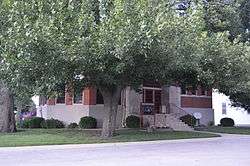Loda, Illinois
| Loda | |
|---|---|
| Village | |
|
The village's public library | |
 Location of Loda in Iroquois County, Illinois. | |
| Coordinates: 40°31′03″N 88°04′19″W / 40.51750°N 88.07194°WCoordinates: 40°31′03″N 88°04′19″W / 40.51750°N 88.07194°W | |
| Country |
|
| State |
|
| County | Iroquois |
| Township | Loda |
| Area[1] | |
| • Total | 1.46 sq mi (3.77 km2) |
| • Land | 1.45 sq mi (3.75 km2) |
| • Water | 0.01 sq mi (0.02 km2) |
| Elevation | 778 ft (237 m) |
| Population (2010) | |
| • Total | 407 |
| • Estimate (2016)[2] | 397 |
| • Density | 274.36/sq mi (105.95/km2) |
| ZIP code | 60948 |
| Area code(s) | 815 |
| FIPS code | 17-44264 |
| Website | Village of Loda |
Loda is a village in Loda Township, Iroquois County, Illinois, United States. As of the 2000 census, its population was 419.
History
A post office called Loda has been in operation since 1880.[3] The name Loda comes from a poem by Ossian.[4]
Geography
Loda is located at 40°30′59″N 88°4′26″W / 40.51639°N 88.07389°W (40.516400, -88.073975).[5]
According to the 2010 census, the village has a total area of 1.46 square miles (3.8 km2), of which 1.45 square miles (3.8 km2) (or 99.32%) is land and 0.01 square miles (0.026 km2) (or 0.68%) is water.[6]
Bayles Lake is a freshwater reservoir located near Loda.
Demographics
| Historical population | |||
|---|---|---|---|
| Census | Pop. | %± | |
| 1880 | 635 | — | |
| 1890 | 598 | −5.8% | |
| 1900 | 668 | 11.7% | |
| 1910 | 603 | −9.7% | |
| 1920 | 530 | −12.1% | |
| 1930 | 499 | −5.8% | |
| 1940 | 507 | 1.6% | |
| 1950 | 559 | 10.3% | |
| 1960 | 585 | 4.7% | |
| 1970 | 525 | −10.3% | |
| 1980 | 486 | −7.4% | |
| 1990 | 390 | −19.8% | |
| 2000 | 419 | 7.4% | |
| 2010 | 407 | −2.9% | |
| Est. 2016 | 397 | [2] | −2.5% |
As of the census[8] of 2000, there were 419 people, 166 households, and 111 families residing in the village. The population density was 289.4 people per square mile (111.6/km²). There were 183 housing units at an average density of 126.4 per square mile (48.7/km²). The racial makeup of the village was 94.03% White, 2.63% African American, 2.15% from other races, and 1.19% from two or more races. Hispanic or Latino of any race were 5.49% of the population.
There were 166 households out of which 30.7% had children under the age of 18 living with them, 54.2% were married couples living together, 9.6% had a female householder with no husband present, and 33.1% were non-families. 30.1% of all households were made up of individuals and 16.3% had someone living alone who was 65 years of age or older. The average household size was 2.52 and the average family size was 3.20.
In the village, the population was spread out with 26.5% under the age of 18, 9.1% from 18 to 24, 24.6% from 25 to 44, 24.1% from 45 to 64, and 15.8% who were 65 years of age or older. The median age was 40 years. For every 100 females there were 94.9 males. For every 100 females age 18 and over, there were 102.6 males.
The median income for a household in the village was $36,625, and the median income for a family was $42,708. Males had a median income of $32,750 versus $19,250 for females. The per capita income for the village was $18,877. About 8.5% of families and 16.0% of the population were below the poverty line, including 27.8% of those under age 18 and 11.3% of those age 65 or over.
References
- ↑ "2016 U.S. Gazetteer Files". United States Census Bureau. Retrieved Jun 29, 2017.
- 1 2 "Population and Housing Unit Estimates". Retrieved June 9, 2017.
- ↑ "Iroquois County". Jim Forte Postal History. Retrieved 21 June 2015.
- ↑ Gannett, Henry (1905). The Origin of Certain Place Names in the United States. U.S. Government Printing Office. p. 189.
- ↑ "US Gazetteer files: 2010, 2000, and 1990". United States Census Bureau. 2011-02-12. Retrieved 2011-04-23.
- ↑ "2010 Census U.S. Gazetteer Files for Places – Illinois". United States Census. Retrieved 2012-10-13.
- ↑ "Census of Population and Housing". Census.gov. Retrieved June 4, 2015.
- ↑ "American FactFinder". United States Census Bureau. Retrieved 2008-01-31.
